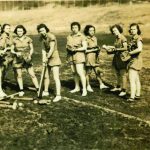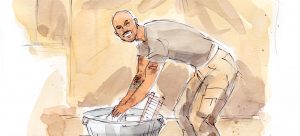
Five local doctors use art to heed time-honored biblical advice
Dr. Bobby Doolittle Dobro Cures What Ails You
By Grant Britt • Photograph by Sam Froelich
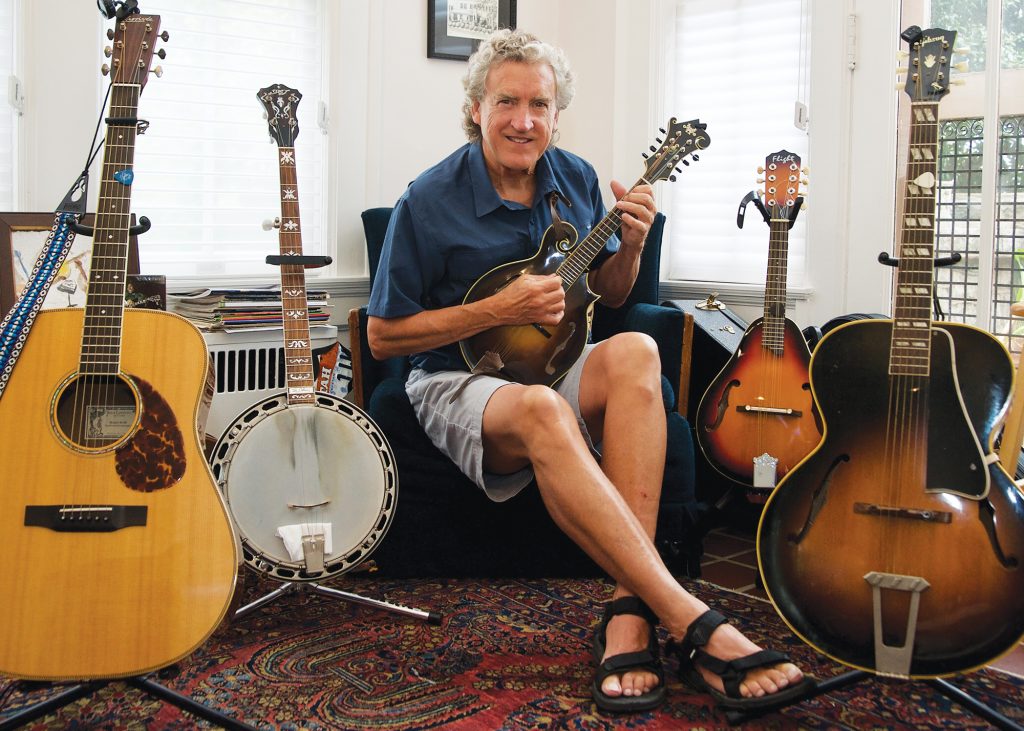
There’s an instrument in Dr. Bobby Doolittle’s little black bag you won’t find in many doctor’s arsenal of healing tools. But that pear-shaped hunk of wood with the four courses of double strings is not there for the patients. Dr Doolitle’s mandolin is a healing tool for the physician, a device that enables him to maintain his own health after ministering to his patients.
Doolittle is done with doctorin’ for now, retiring a few months ago after decades of service in adolescent medicine. “They thought I was a pediatrician, but I was an internist first,” Doolittle says. “My training was internal medicine, but I did a specialty fellowship in adolescent medicine, tried to work a lot with kids, teens and young adults mainly.” But the good doctor found that it’s tough to make a living doing just that. “So the last 25 years I worked at an urgent care center [Cone Health’s Urgent Medical & Family Care]. I saw lots of adolescents by referral from people all over the city, particularly psychologists who needed them to see somebody.”
Music has been in Doolittle’s bloodstream longer than medicine, going back to his own adolescent years in Muscle Shoals, Alabama. “I grew up with a piano-playing mama who was fantastic, so I started playing in bands in high school, grew up in Muscle Shoals,” he recalls. You’ve heard of all those guys in the movie, [2013’s Muscle Shoals documentary, featuring the Fame Studios band, the Swampers] they were in the other high school bands; mine didn’t make it, and theirs did,” Doolittle chuckles.
Doolittle never thought for a minute about playing music for a living, but kept up his chops on organ, then guitar, taking lessons from local string-pulling legend Scott Manring. “About five or six years later I added the mandolin because my wife gave me a mandolin instead of giving me a wedding ring when we got married in ’75. Doolittle took classes from 1982 until 2000, “every Thursday at lunch, then he fired me, and said, ‘Look, just go get a band to play in and quit coming in and horsing around.’”
So Doolittle gave up horsing around for hopping around: For the last 15 years, he has been playing with the Alley Rabbits, whose music was described by a band member’s wife as “aging hippie acoustic folkgrass.” He’s in a jazz trio called String Swing that plays old-fashioned American standards including some Gershwin, a smattering of Duke Ellington and a pinch of early Django Rhinehardt. He also plays in a Latin Swing band serving up salsas and rumbas.
In addition to the fun it’s provided him, music has also heaped its share of therapeutic benefits on Doolittle. “I see it as a major way to let your soul get out of there when medicine is stripping you of your human values, or your humanity,” he observes. “There’s an intensity that goes along with the practice of medicine, having to deal with the preciseness of it, the science part and the bureaucracy of it, the insurance companies, the federal government.”
He contends that “music has this way of going beyond anything words can describe to keep you healthy.”
But while the doctor prescribes that medicine for himself, he’s not too keen on treating patients with it. “It really ought to be about them,” he says. Otherwise, a physician risks contracting a condition known as rockgawd-itis. “As a musician, you really have to be careful, because there’s a point where it becomes about you, then your head swells with a kind of hubris, and you don’t want to ever get there,” Doolittle says.
He also believes that not just the proverbial apple a day but “something artistic and something athletic every day,” should be a part of everyone’s regimen. “There is such a thing as music therapy, and I think it’s really good, I think there’s a future for it.”
Dr. Laura Lomax A prescription for poetry
By Nancy Oakley • Photograph by Amy Freeman
 “You always wonder about the road you didn’t take. It makes me think: I wish I could have [lived] the movie, Sliding Doors, to see what it would have been like,” says Dr. Laura Lomax, with an easy laugh. The road she did take was dermatology, which she has practiced for nearly three decades at Greensboro Dermatology Associates. It was a circuitous route, from her initial plan of becoming a pediatrician, then an internist, but during her fourth rotation as a medical student, she found dermatologists to be “smart, savvy people.” And the practice of treating disorders and diseases of the skin had its benefits: Patients are more apt to follow their prescribed treatment, because they can actually see the results and, as medical practices go, dermatology doesn’t typically involve the stress of the ER or late-night calls — a boon when you’re raising a family.
“You always wonder about the road you didn’t take. It makes me think: I wish I could have [lived] the movie, Sliding Doors, to see what it would have been like,” says Dr. Laura Lomax, with an easy laugh. The road she did take was dermatology, which she has practiced for nearly three decades at Greensboro Dermatology Associates. It was a circuitous route, from her initial plan of becoming a pediatrician, then an internist, but during her fourth rotation as a medical student, she found dermatologists to be “smart, savvy people.” And the practice of treating disorders and diseases of the skin had its benefits: Patients are more apt to follow their prescribed treatment, because they can actually see the results and, as medical practices go, dermatology doesn’t typically involve the stress of the ER or late-night calls — a boon when you’re raising a family.
Even so, Dr. Lomax continued to hear the siren call of that road not taken, the same road that physicians, from John Keats to William Carlos Williams have also followed: poetry. It was an avocation that dates to her childhood right here in the Gate City. “My dad liked rhyme. Before I could read, he would encourage me make little rhymes,” Lomax recalls. “My mom was one of those people who was a natural-born storyteller. Mainly family stories and that sort of thing, but she was just a real talker and good conversationalist and so, I got to love words,” the physician says.
Lomax started dabbling in verse as early as middle school, at Kiser. She would go on to head up a literary magazine in high school at Grimsley, where she devoured poetry in her English classes, a frequent topic of conversation with her sister-in-law, who is a poet and English teacher.
Though poetry and literature were her first love, Lomax also liked math and the sciences. “I have a brother who’s a physician and he influenced me,” she says, adding that it seemed easier to parlay math and science into a career than writing. And practical and economic reasons aside, a life in letters was off-putting for another reason. “I couldn’t see that I was a solitary enough worker to be a writer,” Lomax explains, adding that she is “sort of on that cusp of being extroverted and introverted.”
Being on the cusp gave Lomax perspective and fuel for her pen, which she picked up again midway through her medical career. “Dealing with peoples’ problems — not just the problems they came to you for, but their problems in general — deepens your understanding of human nature and the human condition,” she observes, adding that “ all that emotion and weight have to go somewhere.”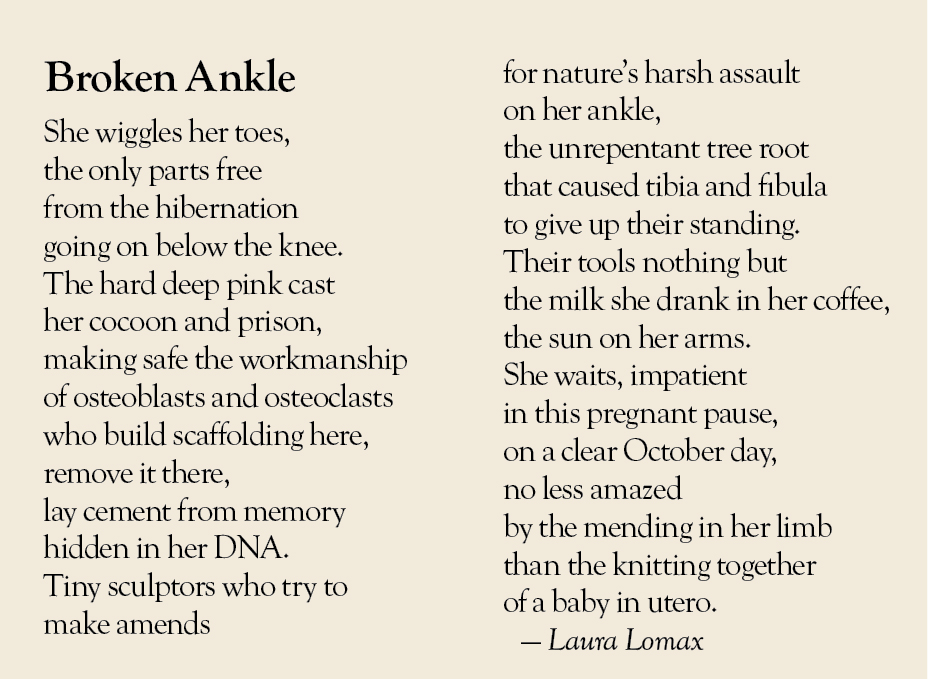
For Lomax, that might mean crafting a poem about camellias in bloom, the creative process, the ebb and flow of daily life. She prefers free verse to the rhymes of her childhood, because “It’s harder to write rhyme in a way that gets across deep thoughts without sounding corny.” Free verse, she adds, “just gives you a lot of leeway in terms of word choice, and it sounds stupid, but the freedom to use phrases that wouldn’t fit.” She enjoys the economy the genre requires, applying the discipline and precision required in medicine to adding and subtracting words, and reworking lines and stanzas.
In the last year, Lomax has joined an informal poetry group that meets once a month. It’s a mix of “retired English teachers and professors,” for the most part, and by happy coincidence, some neighbors. Most important, she says, “It has kept me writing poetry, and writing more. And also getting good feedback from people who are writing poetry.”
As her trove of poems grows, the physician/wordsmith hopes to publish a volume some day. Already she’s off to a good start, with “Wild Words,” which appeared among the pages of this very magazine in August of this year. It caught the attention of some of her patients, one of whom is also a poet. “She wrote me and we’re going to get together and share poems,” says Lomax, with a twinkle in her eye. As for her colleagues in the medical community? “They’re probably saying, ‘Why doesn’t she devote herself a little bit more to dermatology?’” Lomax speculates, her hearty laugh once again tumbling forth as easily as her words onto the page.
Dr. John Wrenn The balm of oils on canvas
By Cynthia Adams • Photograph by Amy Freeman
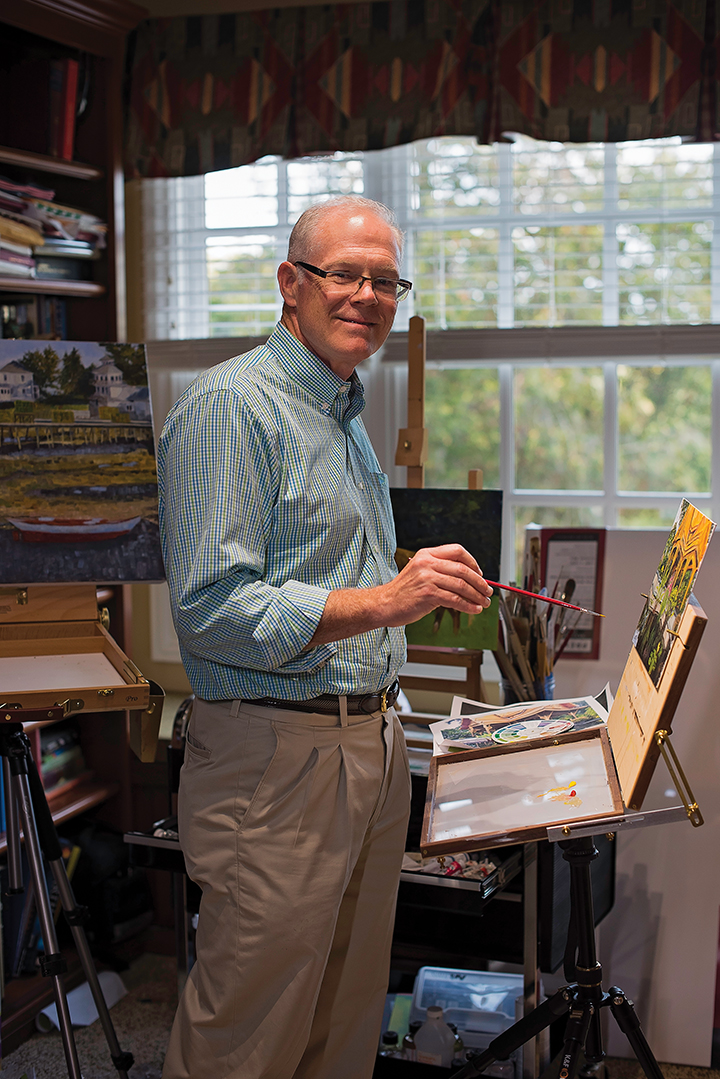 Dr. John Wrenn is a Triad urologist who good-naturedly calls himself a “serial hobbyist.” After hours, he used his free time to master new things, woodworking, for instance.
Dr. John Wrenn is a Triad urologist who good-naturedly calls himself a “serial hobbyist.” After hours, he used his free time to master new things, woodworking, for instance.
Then, a funny thing happened several years ago. While doodling during an office retreat, a tree began to emerge. Something took root in him, too, and Wrenn ordered a pencil set online.
Working with pencil and paper he began experimenting, sketching his brother-in-law’s dog and his own golden doodle. “There was a lot of erasing going on,” he laughs.
Afterward, he turned to human subjects and sketched his daughter, “just playing around” with technique, and he finds an early drawing of his children. “They hate this,” he observes wryly. Wrenn persisted, working quickly and often, using a variety of media. His technique and eye began to develop.
“I have a fairly compressed learning curve,” he says. “I started trying to figure out perspective.” He took lessons under local artist Addren Doss, who exhibits her work at Tyler White Gallery.
In 2013, Wrenn discovered pastels, “which give a broad range and super saturation of colors. And I like it because it’s fast.”
A variety of subjects grabbed his attentions, especially coastal scenes, and he worked from sketches or his own photographs. Sometimes he used vintage snapshots, like one of his father at the Outer Banks, during a 1950s fishing trip.
Wrenn took more classes, learning about composition and perspective. As his skill evolved he dabbled in watercolor and then advanced to oil. Oil was a challenge. “At the time, I thought it was beautiful art,” he says before admitting with the same self-deprecating humor, “No, it wasn’t.”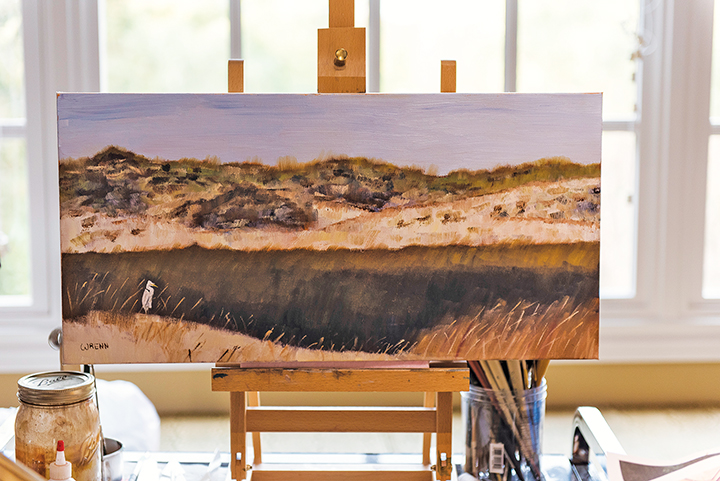
He painted still lifes: sunflowers, sunsets, flowers, a trapper cabin in Georgia, even mailboxes at the sea. Initially, he worked in a realistic style. Gaining skill and confidence, Wrenn varied not only the medium but technique, moving between realism and abstraction.
Working from a photo of Snake Mountain near Boone, a place where his family has property, he created a large piece that at 12” x 24” is among his favorites. “As my wife will tell you, I can dive into things with intensity,” Wrenn admits. Now whenever he can, he sketches or paints.
Most important for his art’s sake, Wrenn is a keen observer.
Some of his most arresting and original scenes include a city intersection, an abstraction of a fire station near Lake Jeanette, a sunset over a local lake and a simple flower. “I’ve always liked art,” he says, showing a range of subjects and composition, moving from still lifes to portraiture.
“I never knew I had any talent,” says Wrenn.
As for the art of medicine, the Memphis native graduated from Davidson College, returning back home to attend the University of Tennessee College of Medicine. Wrenn now works within Greensboro’s Cone Health Group.
“My father was the first pediatric surgeon at St. Jude’s Hospital,” he says. “He worked on the smallest of the small.” Notably, he has painted his much-admired father in various scenarios.
He has always admired people who attempted many things. “I created this of the Grand Canyon from a purloined picture,” he says of an image with particular intensity, of surreal colors, as is the place itself. His work reveals a steady progression; it also reveals him.
“It’s pretty good,” Wrenn says quietly, nodding. In his off hours, he is
an artist.
Artists have freedom. They’re free to to start over, erase, paint over mistakes. If the end result doesn’t work, there is a fresh canvas.
Nobody suffers. Nobody dies.
Turns out, the making of art, in and of itself, is good medicine, especially for this doctor.
Dr. Stephen South & Dr. Ravi Avva Through Two Lenses
Story and Photograph by Lynn Donovan
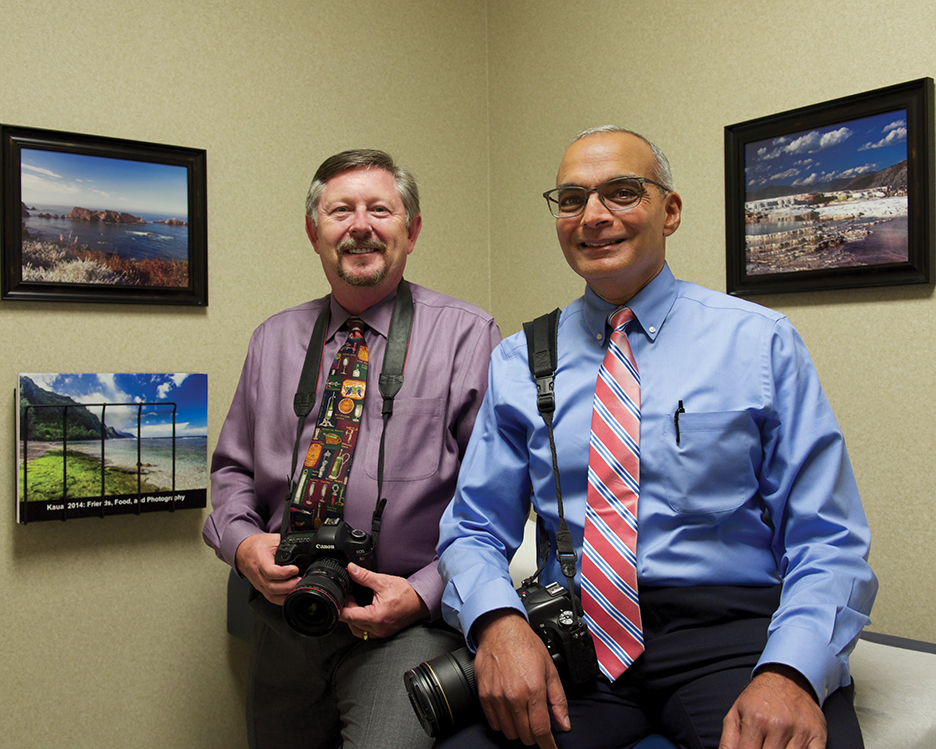 What are the odds of two doctors at the same medical practice using the same art form to express their creative sides and soothe their souls? Dr. Stephen South and Dr. Ravi Avva both practice internal medicine at Guilford Medical Associates and both are also serious photographers. After graduating with a degree in chemistry from UNCG and getting a medical degree from Bowman Gray/WFU, Dr. South did his residency in internal medicine in Roanoke and completed a fellowship in endocrinology in Charlottesville at UVA before settling in Greensboro in 1992. Dr. Avva is a native of Greensboro, born at Cone Hospital. With an undergraduate degree from Carolina and a Ph. D. from Yale, he did his residency at Duke before coming to Guilford Medical in 1998. Both became interested in photography while in school.
What are the odds of two doctors at the same medical practice using the same art form to express their creative sides and soothe their souls? Dr. Stephen South and Dr. Ravi Avva both practice internal medicine at Guilford Medical Associates and both are also serious photographers. After graduating with a degree in chemistry from UNCG and getting a medical degree from Bowman Gray/WFU, Dr. South did his residency in internal medicine in Roanoke and completed a fellowship in endocrinology in Charlottesville at UVA before settling in Greensboro in 1992. Dr. Avva is a native of Greensboro, born at Cone Hospital. With an undergraduate degree from Carolina and a Ph. D. from Yale, he did his residency at Duke before coming to Guilford Medical in 1998. Both became interested in photography while in school.
Dr. South began medical school at Bowman Gray as a newlywed, and after the rigors of that first year, began to feel a bit overwhelmed. Inorder to “feel like I had some time to myself,” he enrolled in a six-week course in photography at Wake Forest, bringing with him a little darkroom knowledge from his time working on his high school yearbook in Randleman.
Dr. Avva developed his interest in photography at the N.C. School of Science and Mathematics in Durham It was there that he also developed an affinity for photographing landscapes. While an undergraduate at Carolina, he too lent his talents to the yearbook.
While both men have many things in common, they followed separate paths on choice of camera equipment. Dr. South began as a dedicated Minolta fan until the digital age took hold. He became a Canon shooter about 15 years ago. Dr. Avva began on Nikon and has stayed with Nikon, switching to digital about 10 years ago. Both enjoy landscapes, but Dr. South feels that people ruin a good picture and typically prefers wildlife and nature photography. Dr. Avva loves to capture family events, vacations and beautiful scenery.
Both have honed their camera skills and fed their souls while traveling all over the United States and the world. Their choice of destination is dictated first by what they want to photograph. But they both admit to being swayed by how good the food and wine are. They have taken two trips together, one to Hawaii and most recently to Portugal.
Accompanied on these trips by family and friends, Dr. Avva finds that his art allows him to escape from the stress of daily life. His photos encompass the landscapes and scenic views of his travels, but many also include the people he cares about.
By contrast, Dr. South says that most of his actual photography is done while away from others, hiking up and down trails and valleys or to high vantage points for the “best view.” The best light of the day is sunrise or sunset for most outdoor subjects andtypically these are very quiet and centered times that are calming and energizing at the same time. Being surrounded by nature on a cool morning is an amazing experience, he says. In more recent years with travel to far-flung locales, he’s found increasingly that photography is more of a “healing getaway” than ever before. In recent years, his two daughters, both also photographers, have begun going with him on treks. Sharing their work with others is a big part of the process for both doctors. Framed prints of Dr. South’s grace the walls of the practice and the nursing home where he works. Piles of books showcasing Dr. Avva’s work are in his office and exam rooms for all to enjoy. The art captured through their lenses is no doubt a balm for patients — and in turn, continues to nurture creativity in the physicians behind the Canon and the Nikon. OH

